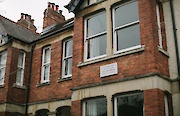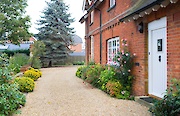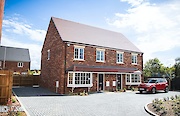


Content Writer

Mortgage Advisor & Director

If you own a listed property, protecting it with the correct level of home insurance is vital. Listed buildings often come with unique features, materials, and legal responsibilities, meaning you need to get a tailored policy. Here we’ll cover how listed building insurance works, average UK costs, and where to find bespoke insurance.
Can you get home insurance on a listed building?
Yes, you can, but listed buildings often require specialist home insurance. That’s because these properties are protected by additional laws and restrictions due to their historical or architectural importance. Restoring them can be more expensive and complex than repairing a standard residential home.
A listed building in the UK will appear on the National Heritage List for England (NHLE), or the equivalent registers in Scotland, Wales, and Northern Ireland. They’re typically graded as:
-
Grade I: Buildings of exceptional interest, only around 2.5% of listed buildings fall into this category.
-
Grade II*: Particularly important buildings of more than special interest, covers around 5% of listed buildings.
-
Grade II: Buildings of special interest, applying to the majority of listed homes, with roughly 92% falling into this category.
Because of these classifications, insurers will often require bespoke policies that take into account the cost of specialist materials, skilled labour, and the need for ‘Listed Building Consent’ when repairs are needed. Standard policies may exclude cover for the true rebuild cost or restoration using traditional techniques.
How insurers assess your application
When you apply for home insurance for a listed building, providers carry out a more detailed risk assessment than they would for a standard property. Here are some key areas they consider when determining your eligibility and premiums:
-
Listed status and building features: Insurers will ask what grade your property is listed as and whether it has specific architectural features, such as thatched roofs, timber framing, or period plasterwork, that could affect the cost or complexity of repairs.
-
Age and construction type: Older homes, especially pre-18th century properties, often use non-standard materials like lime mortar or oak beams. Whether the listed building was built using standard or non-standard construction methods can affect how easily and affordably the home can be insured and restored if needed.
-
Location and environmental risks: Like all homes, listed properties are assessed based on the postcode, along with any specific flood risks, proximity to trees or water, and local crime rates. Also, subsidence risk is especially important for older homes with shallow foundations.
-
Rebuild cost and market value: With listed buildings, the rebuild value is often significantly higher than the market value, because repairs must be completed using original materials and techniques. Your insurer will need an accurate rebuild estimate, often from a specialist RICS surveyor.
-
Previous claims and occupancy: Frequent claims or long periods of unoccupied use (perhaps with second homes) can increase your premiums or limit your home insurance options. Some listed buildings used as holiday lets or B&Bs may also need specific commercial or landlord insurance.
-
Renovations and planning permissions: If you’ve carried out recent renovations or plan to, insurers will want to know if you obtained the necessary Listed Building Consent. Unapproved works you’ve undergone can invalidate an insurance policy.
Average cost of listed building home insurance
The cost of insuring a listed building is highly specific to the property but is usually at least 20% - 50% higher than standard home insurance, due to the additional risks and specialist requirements involved.
While average costs vary based on property details and location, here’s a general guide for a detached 5-bed grade II listed property constructed in 1900 with a market value of £500,000 built using standard construction methods, good home security, £500 excess, and no obvious adverse risks:
|
Type of listed building home insurance |
Average annual cost |
|
Buildings insurance |
£230 - £2,020 |
|
Building and contents insurance |
£280 - £1977 |
Get a bespoke home insurance quotes comparison online
Finding the right home insurance for a listed building can be more complicated than insuring a standard property. With so many unique factors to consider, from specialist materials to Listed Building Consent, it’s not always clear if you’re getting the right level of protection or the best price.
Our home insurance advisers can quickly provide tailored quotes based on your property’s age, grade, and features, and compare policies from multiple insurers that specialise in listed buildings. Whether you need cover for a Grade II listed cottage or a more complex property with conservation requirements, we can help you find a policy.
If you’d like a free, no-obligation chat with a listed building home insurance specialist, you can get started here:

Get a bespoke home insurance quotes comparison
Compare listed building home insurance providers
The best home insurance provider for your listed building will depend on your property's age, location, and specific features. Below are some examples of popular UK insurers that offer cover for listed buildings and heritage homes:
-
Saga: Offers home insurance specifically designed for over 50s, and they cover a wide range of non-standard properties, including listed buildings. The ‘Saga Plus’ policies come with a 3-year fixed price guarantee (if nothing changes) and cover for accidental damage.
-
NFU Mutual: NFU (National Farmers Union) Mutual Insurance Society specialises in countryside and heritage homes. Policies include access to a network of specialised suppliers and tradespeople, worldwide cover for contents, and accidental damage included as standard.
-
Provides buildings and contents cover for various properties, including some listed homes. Their ‘Gold’ and ‘Platinum’ policies include unlimited limits for buildings insurance. They also offer discounts for combining home and car insurance under a multi-policy plan, but home insurance for listed buildings is arranged on a case-by-case basis.
If you’re not sure which provider is best for your listed property, a quick chat with one of our specialist advisers can help you compare quotes and get the right home insurance for your listed building.
Why choose Teito for your home insurance needs?
Finding the right home insurance for a listed building can be complex and confusing without support. At Teito, our advisers specialise in helping homeowners secure tailored protection that fits the unique character and requirements of listed properties.
Our advisers are experts when it comes to home insurance for listed buildings throughout the UK, and they understand the specific challenges of insuring these unique homes. Whether your property is Grade I, II*, or II, we’ll help you get the right level of cover without overpaying.
Here’s why people across the UK trust us to help with their listed building home insurance:
-
We can provide bespoke quotes for your listed property
-
Our advisers are 5-star rated on leading review platforms
-
Your first consultation is free, with no obligation to proceed
-
We have access to specialist insurers offering tailored cover
Ready for a free, no-obligation chat with an adviser specialising in home insurance for listed buildings? Get started here.
FAQs
Yes. Listed building home insurance is available in Scotland, although the terminology differs slightly. Listed properties in Scotland are classified as Category A, B, or C, but the same principles apply. Restoration costs are typically higher, and you’ll need specialist, bespoke home insurance.
Choosing an Adviser
Selecting a qualified and experienced mortgage adviser is of great importance. To choose a suitable adviser, evaluate their qualifications, experience, and reputation, and ensure they are regulated by the Financial Conduct Authority (FCA).
Read reviews from previous clients and make sure they provide a clear explanation of the products and services they offer, as well as the fees and charges associated with them.





















































































































































